Health and Social Care Unit 3: Principles of Communication Assignment
VerifiedAdded on 2023/06/05
|22
|4767
|238
Homework Assignment
AI Summary
This assignment, focusing on Unit 3: Principles of Communication in Health and Social Care, addresses various aspects of effective communication within healthcare settings. It covers the reasons people communicate, the impact of communication on relationships, and the features of two-way communication. The assignment explores how cultural backgrounds influence communication, identifies barriers to effective communication (interpersonal, perceptual, emotional, cultural, language, and gender), and provides strategies to overcome these barriers. It also explains how to clarify misunderstandings and maintain confidentiality. Furthermore, the assignment delves into the importance of meeting service users' individual communication needs, methods for establishing their needs, and accessing support. It examines how one's role impacts communication, analyzes reasons for using informal language systems, and outlines factors for promoting effective communication, including non-verbal cues, communication styles, empathy, and active listening. Finally, it describes non-verbal forms of communication and explores communication methods and styles to meet service users' individual needs, encompassing verbal, non-verbal, written, and visual communication.
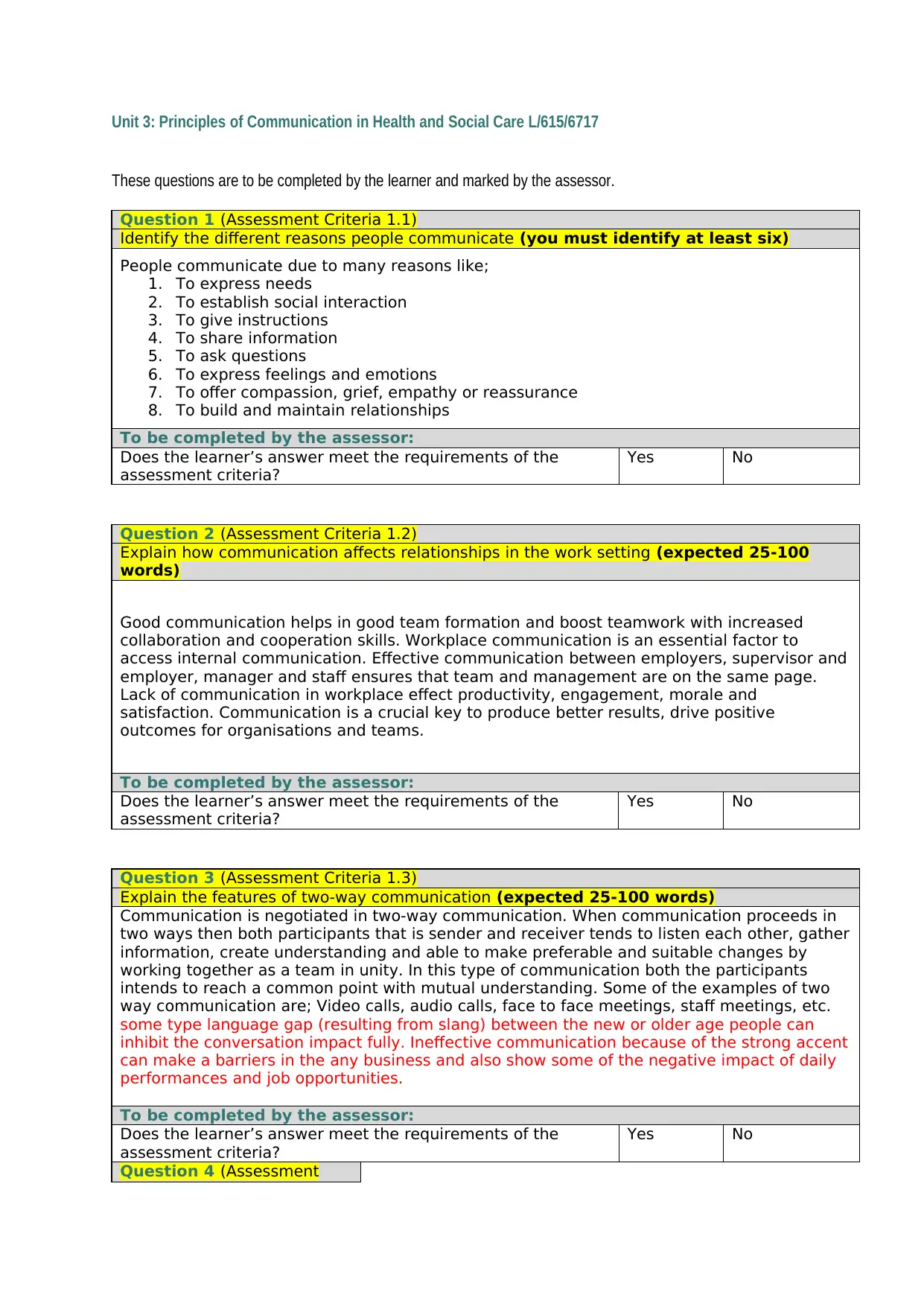
Unit 3: Principles of Communication in Health and Social Care L/615/6717
These questions are to be completed by the learner and marked by the assessor.
Question 1 (Assessment Criteria 1.1)
Identify the different reasons people communicate (you must identify at least six)
People communicate due to many reasons like;
1. To express needs
2. To establish social interaction
3. To give instructions
4. To share information
5. To ask questions
6. To express feelings and emotions
7. To offer compassion, grief, empathy or reassurance
8. To build and maintain relationships
To be completed by the assessor:
Does the learner’s answer meet the requirements of the
assessment criteria?
Yes No
Question 2 (Assessment Criteria 1.2)
Explain how communication affects relationships in the work setting (expected 25-100
words)
Good communication helps in good team formation and boost teamwork with increased
collaboration and cooperation skills. Workplace communication is an essential factor to
access internal communication. Effective communication between employers, supervisor and
employer, manager and staff ensures that team and management are on the same page.
Lack of communication in workplace effect productivity, engagement, morale and
satisfaction. Communication is a crucial key to produce better results, drive positive
outcomes for organisations and teams.
To be completed by the assessor:
Does the learner’s answer meet the requirements of the
assessment criteria?
Yes No
Question 3 (Assessment Criteria 1.3)
Explain the features of two-way communication (expected 25-100 words)
Communication is negotiated in two-way communication. When communication proceeds in
two ways then both participants that is sender and receiver tends to listen each other, gather
information, create understanding and able to make preferable and suitable changes by
working together as a team in unity. In this type of communication both the participants
intends to reach a common point with mutual understanding. Some of the examples of two
way communication are; Video calls, audio calls, face to face meetings, staff meetings, etc.
some type language gap (resulting from slang) between the new or older age people can
inhibit the conversation impact fully. Ineffective communication because of the strong accent
can make a barriers in the any business and also show some of the negative impact of daily
performances and job opportunities.
To be completed by the assessor:
Does the learner’s answer meet the requirements of the
assessment criteria?
Yes No
Question 4 (Assessment
These questions are to be completed by the learner and marked by the assessor.
Question 1 (Assessment Criteria 1.1)
Identify the different reasons people communicate (you must identify at least six)
People communicate due to many reasons like;
1. To express needs
2. To establish social interaction
3. To give instructions
4. To share information
5. To ask questions
6. To express feelings and emotions
7. To offer compassion, grief, empathy or reassurance
8. To build and maintain relationships
To be completed by the assessor:
Does the learner’s answer meet the requirements of the
assessment criteria?
Yes No
Question 2 (Assessment Criteria 1.2)
Explain how communication affects relationships in the work setting (expected 25-100
words)
Good communication helps in good team formation and boost teamwork with increased
collaboration and cooperation skills. Workplace communication is an essential factor to
access internal communication. Effective communication between employers, supervisor and
employer, manager and staff ensures that team and management are on the same page.
Lack of communication in workplace effect productivity, engagement, morale and
satisfaction. Communication is a crucial key to produce better results, drive positive
outcomes for organisations and teams.
To be completed by the assessor:
Does the learner’s answer meet the requirements of the
assessment criteria?
Yes No
Question 3 (Assessment Criteria 1.3)
Explain the features of two-way communication (expected 25-100 words)
Communication is negotiated in two-way communication. When communication proceeds in
two ways then both participants that is sender and receiver tends to listen each other, gather
information, create understanding and able to make preferable and suitable changes by
working together as a team in unity. In this type of communication both the participants
intends to reach a common point with mutual understanding. Some of the examples of two
way communication are; Video calls, audio calls, face to face meetings, staff meetings, etc.
some type language gap (resulting from slang) between the new or older age people can
inhibit the conversation impact fully. Ineffective communication because of the strong accent
can make a barriers in the any business and also show some of the negative impact of daily
performances and job opportunities.
To be completed by the assessor:
Does the learner’s answer meet the requirements of the
assessment criteria?
Yes No
Question 4 (Assessment
Paraphrase This Document
Need a fresh take? Get an instant paraphrase of this document with our AI Paraphraser
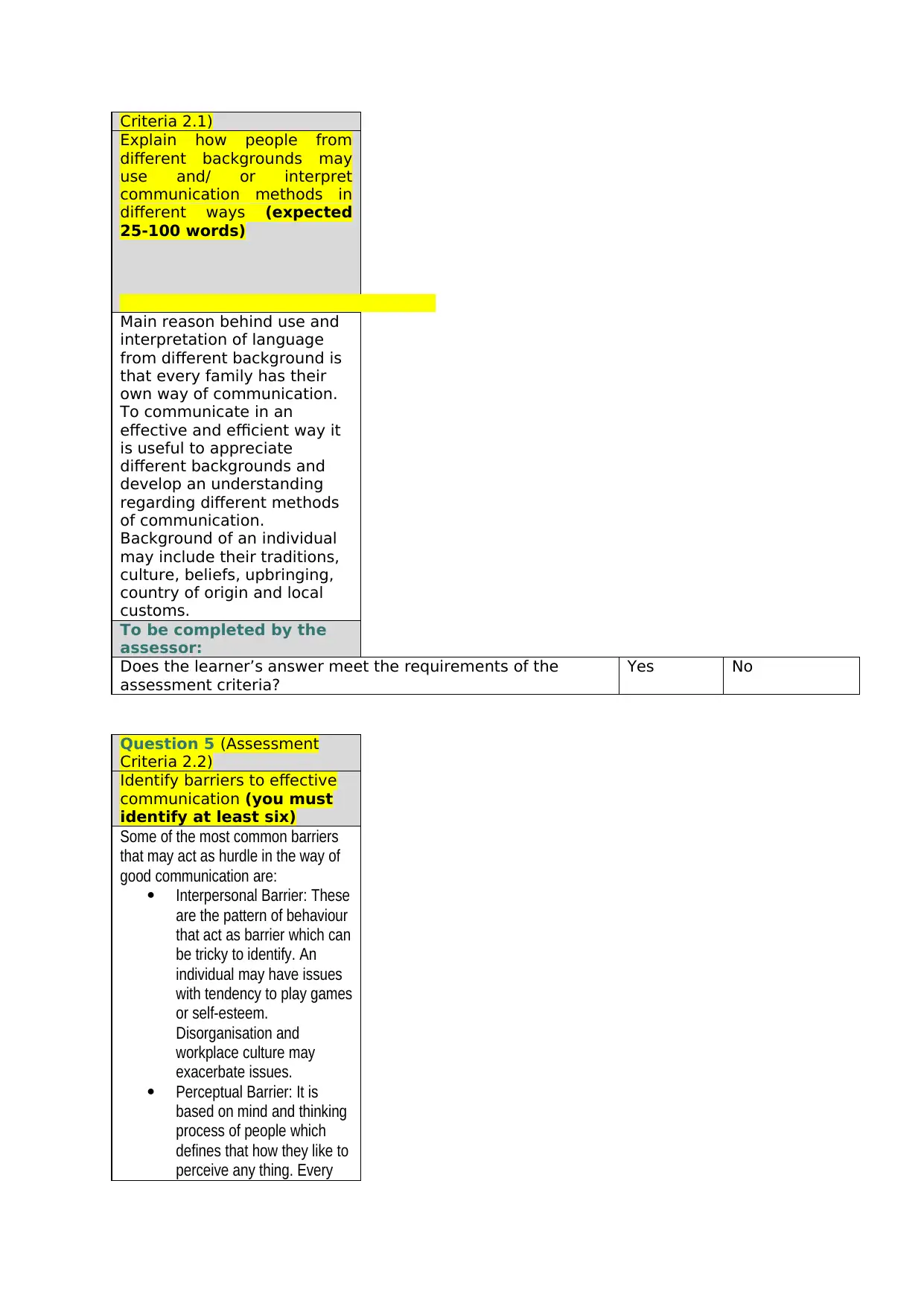
Criteria 2.1)
Explain how people from
different backgrounds may
use and/ or interpret
communication methods in
different ways (expected
25-100 words)
Main reason behind use and
interpretation of language
from different background is
that every family has their
own way of communication.
To communicate in an
effective and efficient way it
is useful to appreciate
different backgrounds and
develop an understanding
regarding different methods
of communication.
Background of an individual
may include their traditions,
culture, beliefs, upbringing,
country of origin and local
customs.
To be completed by the
assessor:
Does the learner’s answer meet the requirements of the
assessment criteria?
Yes No
Question 5 (Assessment
Criteria 2.2)
Identify barriers to effective
communication (you must
identify at least six)
Some of the most common barriers
that may act as hurdle in the way of
good communication are:
Interpersonal Barrier: These
are the pattern of behaviour
that act as barrier which can
be tricky to identify. An
individual may have issues
with tendency to play games
or self-esteem.
Disorganisation and
workplace culture may
exacerbate issues.
Perceptual Barrier: It is
based on mind and thinking
process of people which
defines that how they like to
perceive any thing. Every
Explain how people from
different backgrounds may
use and/ or interpret
communication methods in
different ways (expected
25-100 words)
Main reason behind use and
interpretation of language
from different background is
that every family has their
own way of communication.
To communicate in an
effective and efficient way it
is useful to appreciate
different backgrounds and
develop an understanding
regarding different methods
of communication.
Background of an individual
may include their traditions,
culture, beliefs, upbringing,
country of origin and local
customs.
To be completed by the
assessor:
Does the learner’s answer meet the requirements of the
assessment criteria?
Yes No
Question 5 (Assessment
Criteria 2.2)
Identify barriers to effective
communication (you must
identify at least six)
Some of the most common barriers
that may act as hurdle in the way of
good communication are:
Interpersonal Barrier: These
are the pattern of behaviour
that act as barrier which can
be tricky to identify. An
individual may have issues
with tendency to play games
or self-esteem.
Disorganisation and
workplace culture may
exacerbate issues.
Perceptual Barrier: It is
based on mind and thinking
process of people which
defines that how they like to
perceive any thing. Every
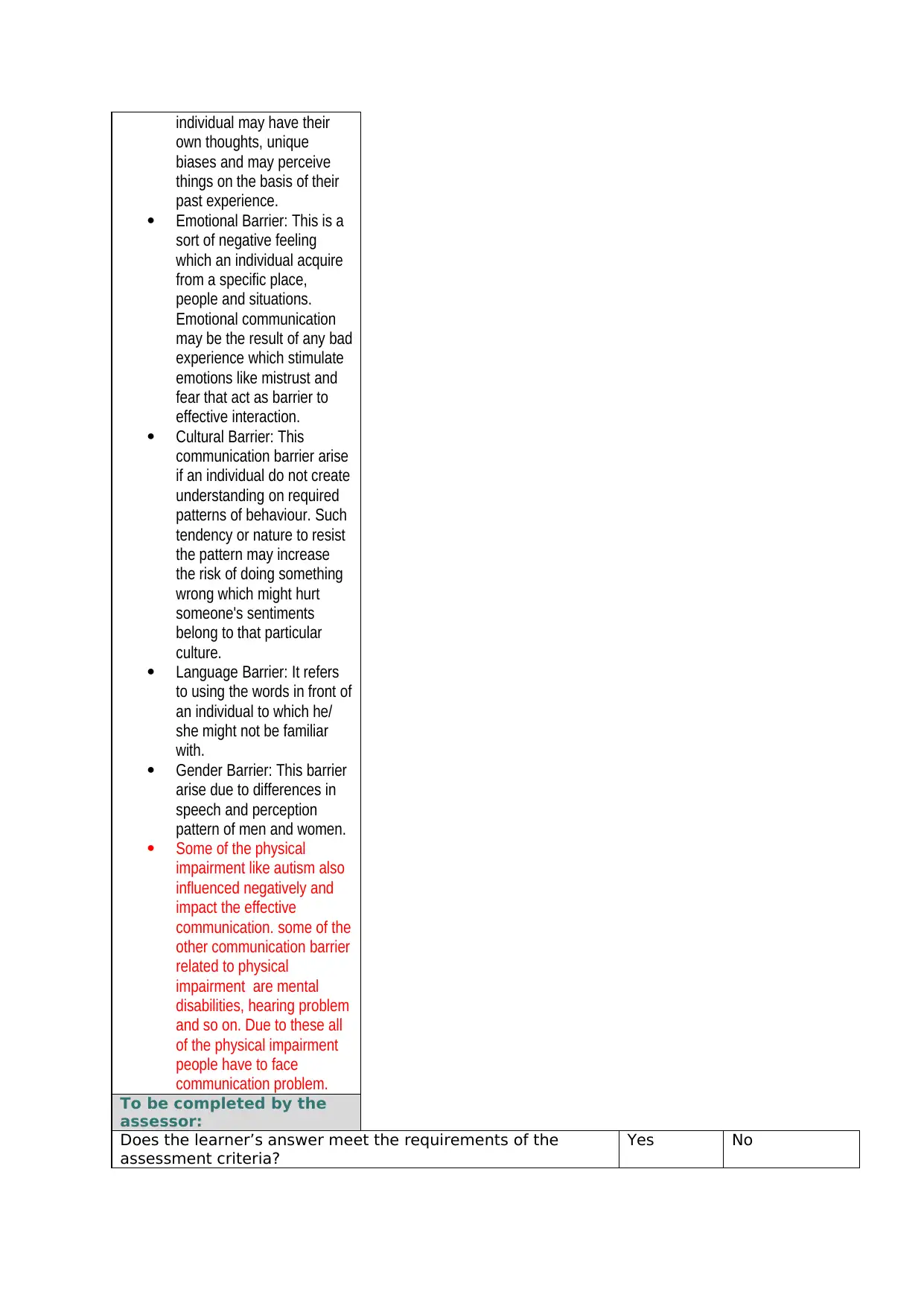
individual may have their
own thoughts, unique
biases and may perceive
things on the basis of their
past experience.
Emotional Barrier: This is a
sort of negative feeling
which an individual acquire
from a specific place,
people and situations.
Emotional communication
may be the result of any bad
experience which stimulate
emotions like mistrust and
fear that act as barrier to
effective interaction.
Cultural Barrier: This
communication barrier arise
if an individual do not create
understanding on required
patterns of behaviour. Such
tendency or nature to resist
the pattern may increase
the risk of doing something
wrong which might hurt
someone's sentiments
belong to that particular
culture.
Language Barrier: It refers
to using the words in front of
an individual to which he/
she might not be familiar
with.
Gender Barrier: This barrier
arise due to differences in
speech and perception
pattern of men and women.
Some of the physical
impairment like autism also
influenced negatively and
impact the effective
communication. some of the
other communication barrier
related to physical
impairment are mental
disabilities, hearing problem
and so on. Due to these all
of the physical impairment
people have to face
communication problem.
To be completed by the
assessor:
Does the learner’s answer meet the requirements of the
assessment criteria?
Yes No
own thoughts, unique
biases and may perceive
things on the basis of their
past experience.
Emotional Barrier: This is a
sort of negative feeling
which an individual acquire
from a specific place,
people and situations.
Emotional communication
may be the result of any bad
experience which stimulate
emotions like mistrust and
fear that act as barrier to
effective interaction.
Cultural Barrier: This
communication barrier arise
if an individual do not create
understanding on required
patterns of behaviour. Such
tendency or nature to resist
the pattern may increase
the risk of doing something
wrong which might hurt
someone's sentiments
belong to that particular
culture.
Language Barrier: It refers
to using the words in front of
an individual to which he/
she might not be familiar
with.
Gender Barrier: This barrier
arise due to differences in
speech and perception
pattern of men and women.
Some of the physical
impairment like autism also
influenced negatively and
impact the effective
communication. some of the
other communication barrier
related to physical
impairment are mental
disabilities, hearing problem
and so on. Due to these all
of the physical impairment
people have to face
communication problem.
To be completed by the
assessor:
Does the learner’s answer meet the requirements of the
assessment criteria?
Yes No
⊘ This is a preview!⊘
Do you want full access?
Subscribe today to unlock all pages.

Trusted by 1+ million students worldwide
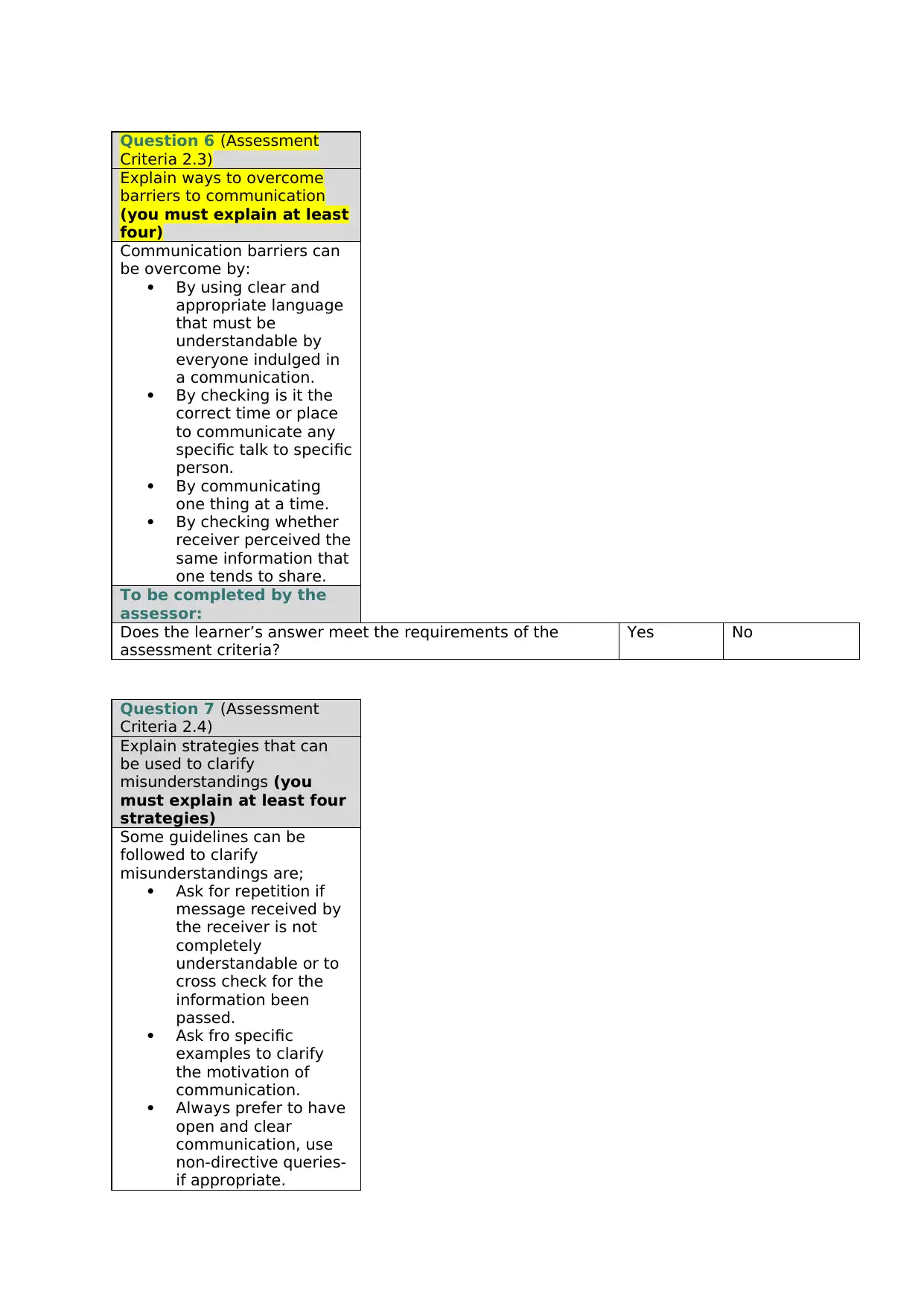
Question 6 (Assessment
Criteria 2.3)
Explain ways to overcome
barriers to communication
(you must explain at least
four)
Communication barriers can
be overcome by:
By using clear and
appropriate language
that must be
understandable by
everyone indulged in
a communication.
By checking is it the
correct time or place
to communicate any
specific talk to specific
person.
By communicating
one thing at a time.
By checking whether
receiver perceived the
same information that
one tends to share.
To be completed by the
assessor:
Does the learner’s answer meet the requirements of the
assessment criteria?
Yes No
Question 7 (Assessment
Criteria 2.4)
Explain strategies that can
be used to clarify
misunderstandings (you
must explain at least four
strategies)
Some guidelines can be
followed to clarify
misunderstandings are;
Ask for repetition if
message received by
the receiver is not
completely
understandable or to
cross check for the
information been
passed.
Ask fro specific
examples to clarify
the motivation of
communication.
Always prefer to have
open and clear
communication, use
non-directive queries-
if appropriate.
Criteria 2.3)
Explain ways to overcome
barriers to communication
(you must explain at least
four)
Communication barriers can
be overcome by:
By using clear and
appropriate language
that must be
understandable by
everyone indulged in
a communication.
By checking is it the
correct time or place
to communicate any
specific talk to specific
person.
By communicating
one thing at a time.
By checking whether
receiver perceived the
same information that
one tends to share.
To be completed by the
assessor:
Does the learner’s answer meet the requirements of the
assessment criteria?
Yes No
Question 7 (Assessment
Criteria 2.4)
Explain strategies that can
be used to clarify
misunderstandings (you
must explain at least four
strategies)
Some guidelines can be
followed to clarify
misunderstandings are;
Ask for repetition if
message received by
the receiver is not
completely
understandable or to
cross check for the
information been
passed.
Ask fro specific
examples to clarify
the motivation of
communication.
Always prefer to have
open and clear
communication, use
non-directive queries-
if appropriate.
Paraphrase This Document
Need a fresh take? Get an instant paraphrase of this document with our AI Paraphraser
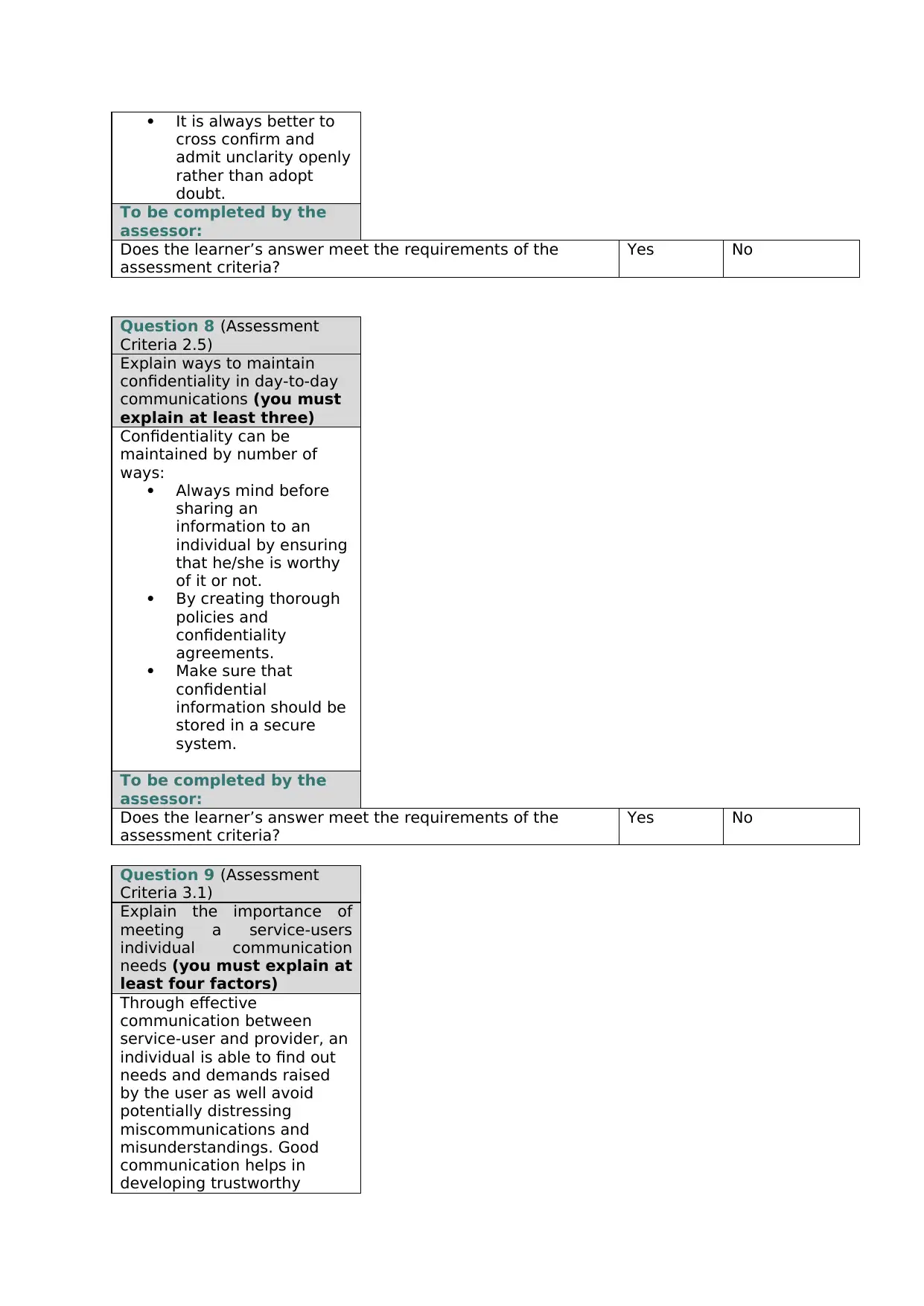
It is always better to
cross confirm and
admit unclarity openly
rather than adopt
doubt.
To be completed by the
assessor:
Does the learner’s answer meet the requirements of the
assessment criteria?
Yes No
Question 8 (Assessment
Criteria 2.5)
Explain ways to maintain
confidentiality in day-to-day
communications (you must
explain at least three)
Confidentiality can be
maintained by number of
ways:
Always mind before
sharing an
information to an
individual by ensuring
that he/she is worthy
of it or not.
By creating thorough
policies and
confidentiality
agreements.
Make sure that
confidential
information should be
stored in a secure
system.
To be completed by the
assessor:
Does the learner’s answer meet the requirements of the
assessment criteria?
Yes No
Question 9 (Assessment
Criteria 3.1)
Explain the importance of
meeting a service-users
individual communication
needs (you must explain at
least four factors)
Through effective
communication between
service-user and provider, an
individual is able to find out
needs and demands raised
by the user as well avoid
potentially distressing
miscommunications and
misunderstandings. Good
communication helps in
developing trustworthy
cross confirm and
admit unclarity openly
rather than adopt
doubt.
To be completed by the
assessor:
Does the learner’s answer meet the requirements of the
assessment criteria?
Yes No
Question 8 (Assessment
Criteria 2.5)
Explain ways to maintain
confidentiality in day-to-day
communications (you must
explain at least three)
Confidentiality can be
maintained by number of
ways:
Always mind before
sharing an
information to an
individual by ensuring
that he/she is worthy
of it or not.
By creating thorough
policies and
confidentiality
agreements.
Make sure that
confidential
information should be
stored in a secure
system.
To be completed by the
assessor:
Does the learner’s answer meet the requirements of the
assessment criteria?
Yes No
Question 9 (Assessment
Criteria 3.1)
Explain the importance of
meeting a service-users
individual communication
needs (you must explain at
least four factors)
Through effective
communication between
service-user and provider, an
individual is able to find out
needs and demands raised
by the user as well avoid
potentially distressing
miscommunications and
misunderstandings. Good
communication helps in
developing trustworthy
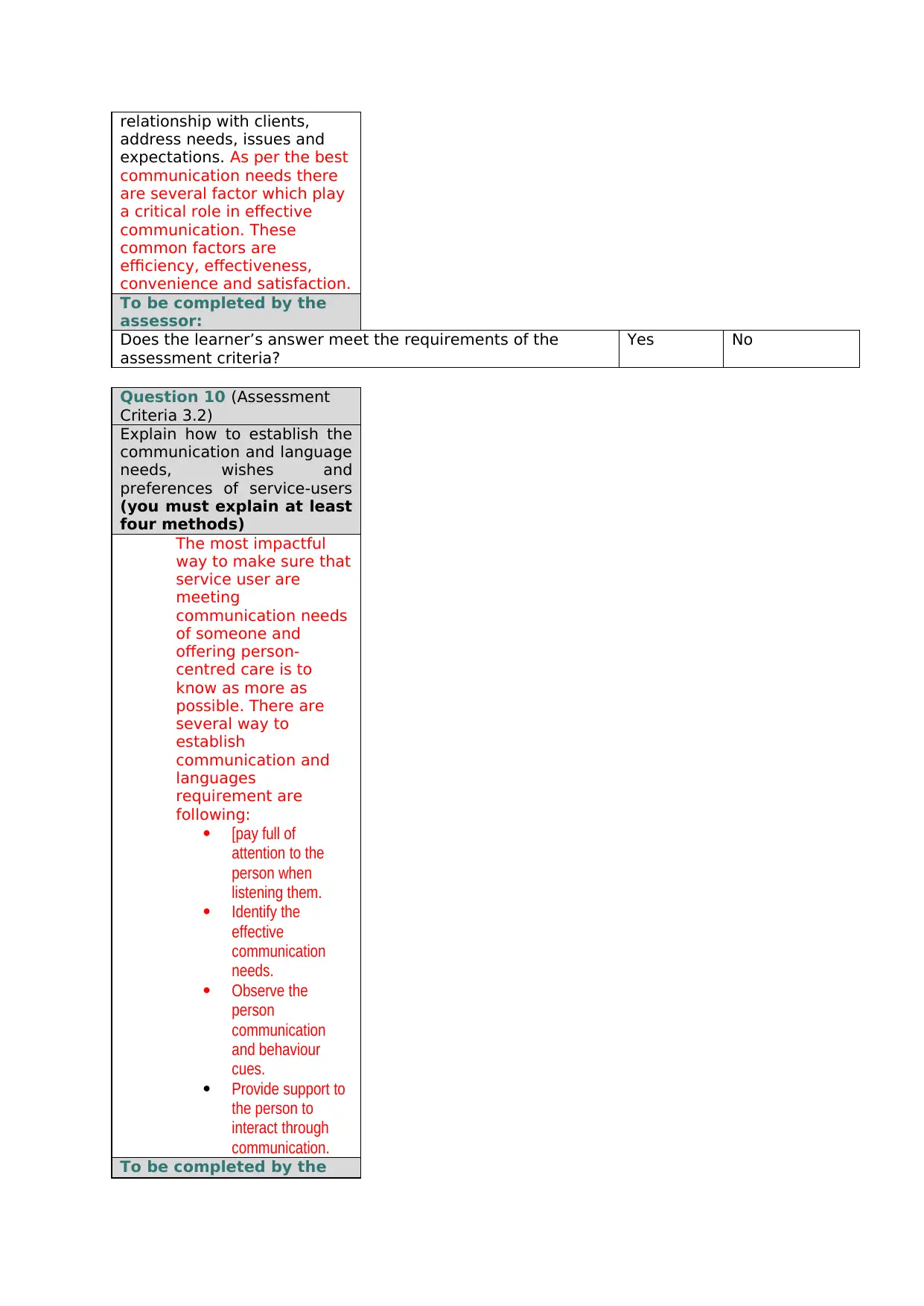
relationship with clients,
address needs, issues and
expectations. As per the best
communication needs there
are several factor which play
a critical role in effective
communication. These
common factors are
efficiency, effectiveness,
convenience and satisfaction.
To be completed by the
assessor:
Does the learner’s answer meet the requirements of the
assessment criteria?
Yes No
Question 10 (Assessment
Criteria 3.2)
Explain how to establish the
communication and language
needs, wishes and
preferences of service-users
(you must explain at least
four methods)
The most impactful
way to make sure that
service user are
meeting
communication needs
of someone and
offering person-
centred care is to
know as more as
possible. There are
several way to
establish
communication and
languages
requirement are
following:
[pay full of
attention to the
person when
listening them.
Identify the
effective
communication
needs.
Observe the
person
communication
and behaviour
cues.
Provide support to
the person to
interact through
communication.
To be completed by the
address needs, issues and
expectations. As per the best
communication needs there
are several factor which play
a critical role in effective
communication. These
common factors are
efficiency, effectiveness,
convenience and satisfaction.
To be completed by the
assessor:
Does the learner’s answer meet the requirements of the
assessment criteria?
Yes No
Question 10 (Assessment
Criteria 3.2)
Explain how to establish the
communication and language
needs, wishes and
preferences of service-users
(you must explain at least
four methods)
The most impactful
way to make sure that
service user are
meeting
communication needs
of someone and
offering person-
centred care is to
know as more as
possible. There are
several way to
establish
communication and
languages
requirement are
following:
[pay full of
attention to the
person when
listening them.
Identify the
effective
communication
needs.
Observe the
person
communication
and behaviour
cues.
Provide support to
the person to
interact through
communication.
To be completed by the
⊘ This is a preview!⊘
Do you want full access?
Subscribe today to unlock all pages.

Trusted by 1+ million students worldwide
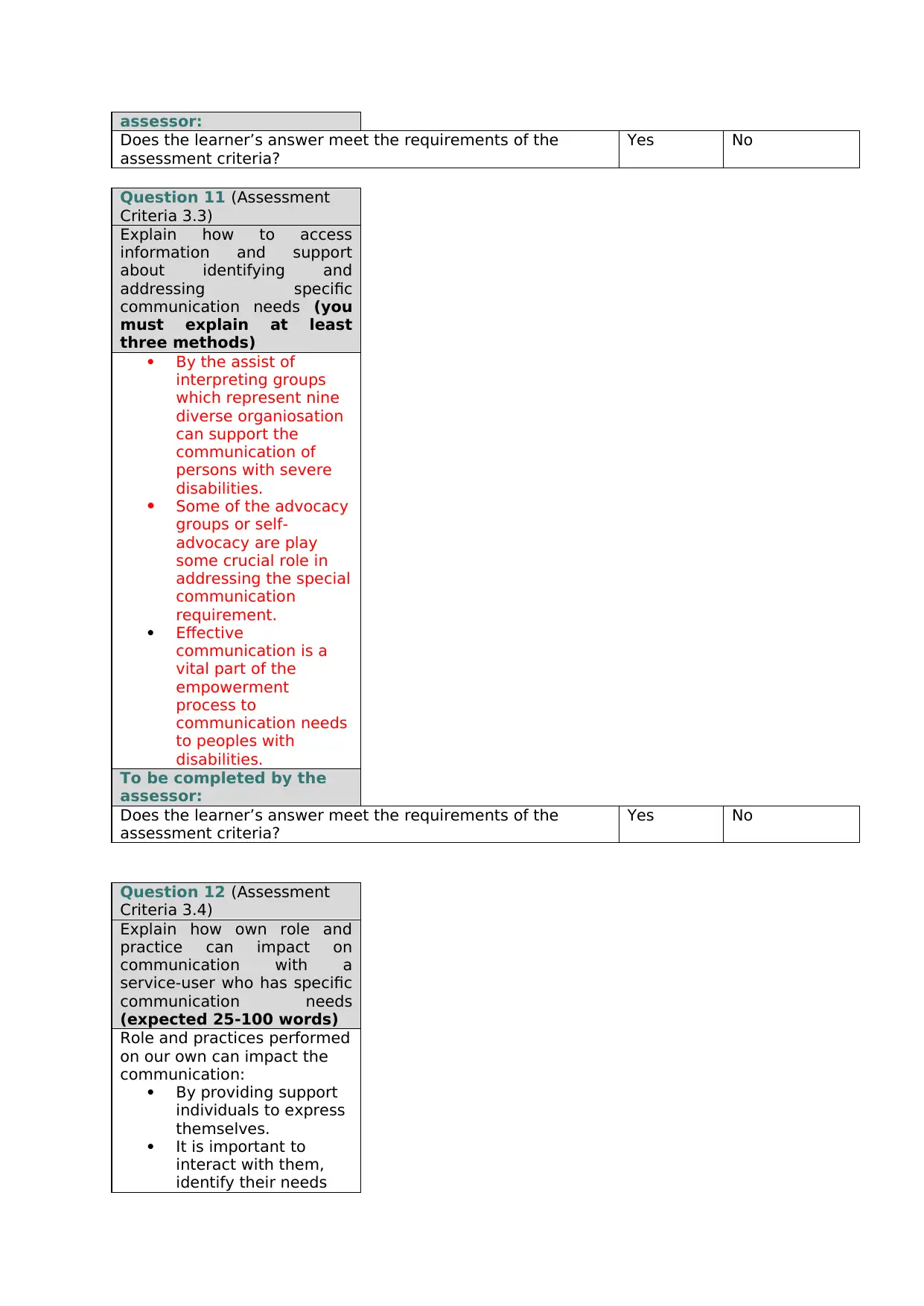
assessor:
Does the learner’s answer meet the requirements of the
assessment criteria?
Yes No
Question 11 (Assessment
Criteria 3.3)
Explain how to access
information and support
about identifying and
addressing specific
communication needs (you
must explain at least
three methods)
By the assist of
interpreting groups
which represent nine
diverse organiosation
can support the
communication of
persons with severe
disabilities.
Some of the advocacy
groups or self-
advocacy are play
some crucial role in
addressing the special
communication
requirement.
Effective
communication is a
vital part of the
empowerment
process to
communication needs
to peoples with
disabilities.
To be completed by the
assessor:
Does the learner’s answer meet the requirements of the
assessment criteria?
Yes No
Question 12 (Assessment
Criteria 3.4)
Explain how own role and
practice can impact on
communication with a
service-user who has specific
communication needs
(expected 25-100 words)
Role and practices performed
on our own can impact the
communication:
By providing support
individuals to express
themselves.
It is important to
interact with them,
identify their needs
Does the learner’s answer meet the requirements of the
assessment criteria?
Yes No
Question 11 (Assessment
Criteria 3.3)
Explain how to access
information and support
about identifying and
addressing specific
communication needs (you
must explain at least
three methods)
By the assist of
interpreting groups
which represent nine
diverse organiosation
can support the
communication of
persons with severe
disabilities.
Some of the advocacy
groups or self-
advocacy are play
some crucial role in
addressing the special
communication
requirement.
Effective
communication is a
vital part of the
empowerment
process to
communication needs
to peoples with
disabilities.
To be completed by the
assessor:
Does the learner’s answer meet the requirements of the
assessment criteria?
Yes No
Question 12 (Assessment
Criteria 3.4)
Explain how own role and
practice can impact on
communication with a
service-user who has specific
communication needs
(expected 25-100 words)
Role and practices performed
on our own can impact the
communication:
By providing support
individuals to express
themselves.
It is important to
interact with them,
identify their needs
Paraphrase This Document
Need a fresh take? Get an instant paraphrase of this document with our AI Paraphraser
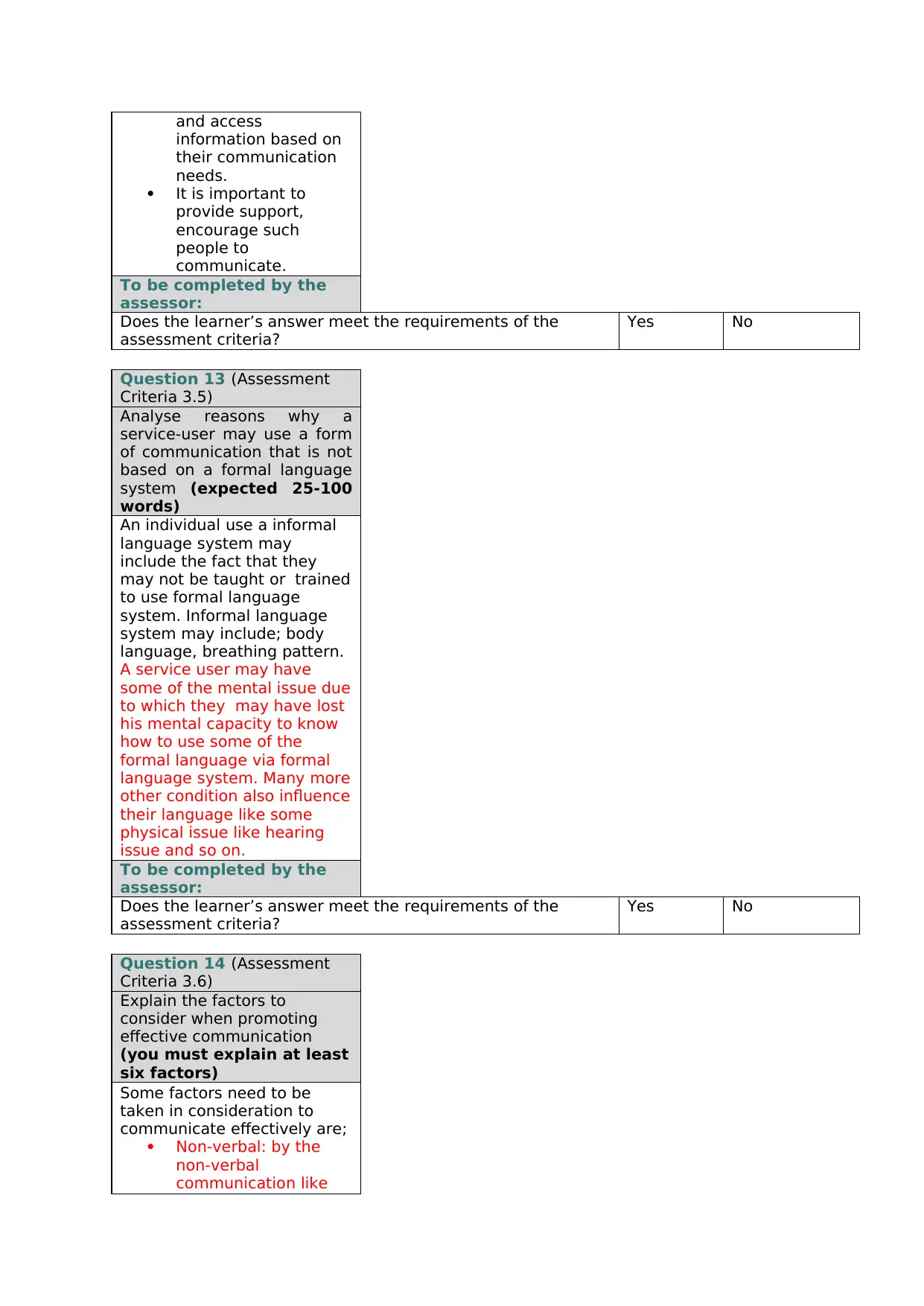
and access
information based on
their communication
needs.
It is important to
provide support,
encourage such
people to
communicate.
To be completed by the
assessor:
Does the learner’s answer meet the requirements of the
assessment criteria?
Yes No
Question 13 (Assessment
Criteria 3.5)
Analyse reasons why a
service-user may use a form
of communication that is not
based on a formal language
system (expected 25-100
words)
An individual use a informal
language system may
include the fact that they
may not be taught or trained
to use formal language
system. Informal language
system may include; body
language, breathing pattern.
A service user may have
some of the mental issue due
to which they may have lost
his mental capacity to know
how to use some of the
formal language via formal
language system. Many more
other condition also influence
their language like some
physical issue like hearing
issue and so on.
To be completed by the
assessor:
Does the learner’s answer meet the requirements of the
assessment criteria?
Yes No
Question 14 (Assessment
Criteria 3.6)
Explain the factors to
consider when promoting
effective communication
(you must explain at least
six factors)
Some factors need to be
taken in consideration to
communicate effectively are;
Non-verbal: by the
non-verbal
communication like
information based on
their communication
needs.
It is important to
provide support,
encourage such
people to
communicate.
To be completed by the
assessor:
Does the learner’s answer meet the requirements of the
assessment criteria?
Yes No
Question 13 (Assessment
Criteria 3.5)
Analyse reasons why a
service-user may use a form
of communication that is not
based on a formal language
system (expected 25-100
words)
An individual use a informal
language system may
include the fact that they
may not be taught or trained
to use formal language
system. Informal language
system may include; body
language, breathing pattern.
A service user may have
some of the mental issue due
to which they may have lost
his mental capacity to know
how to use some of the
formal language via formal
language system. Many more
other condition also influence
their language like some
physical issue like hearing
issue and so on.
To be completed by the
assessor:
Does the learner’s answer meet the requirements of the
assessment criteria?
Yes No
Question 14 (Assessment
Criteria 3.6)
Explain the factors to
consider when promoting
effective communication
(you must explain at least
six factors)
Some factors need to be
taken in consideration to
communicate effectively are;
Non-verbal: by the
non-verbal
communication like
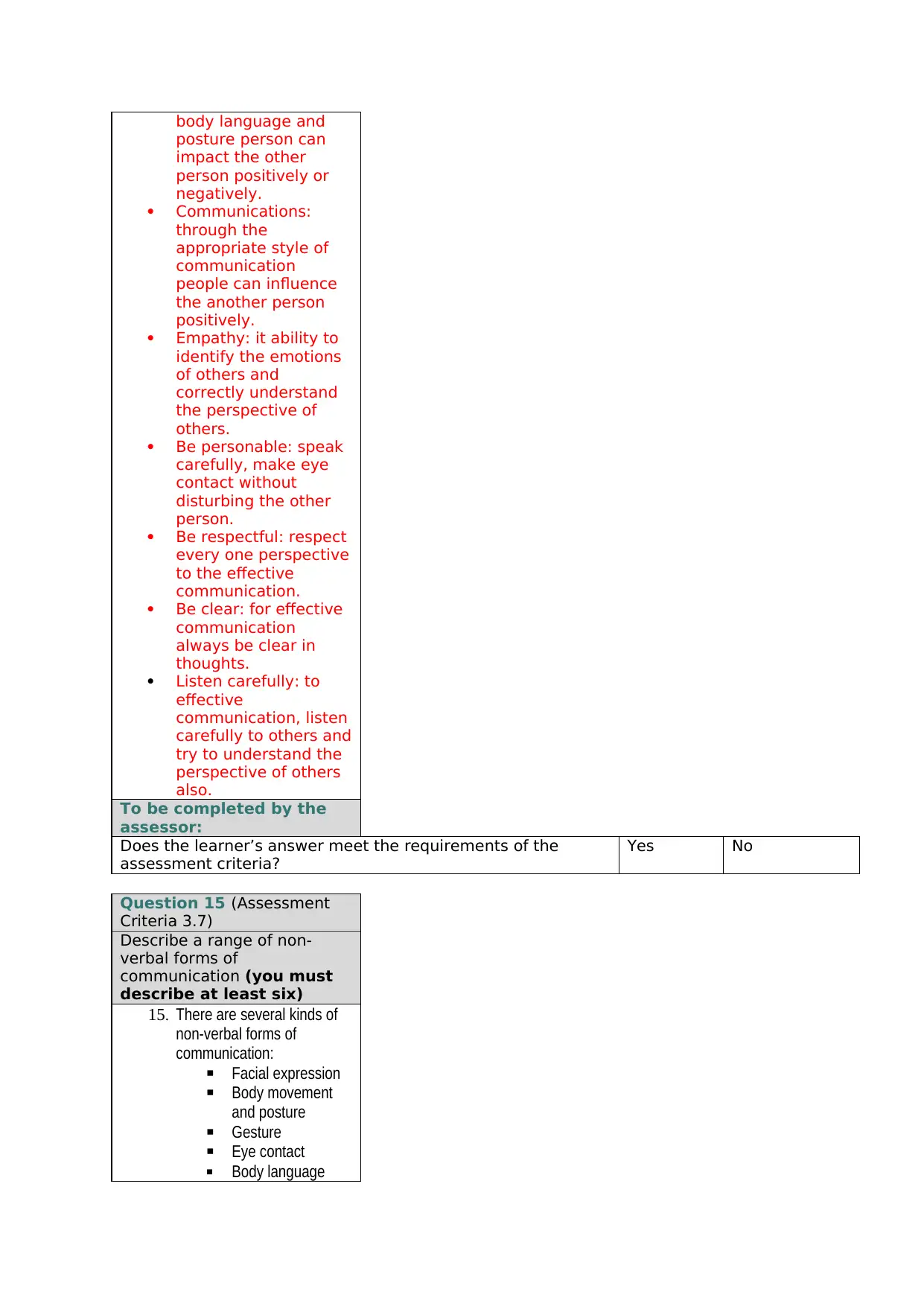
body language and
posture person can
impact the other
person positively or
negatively.
Communications:
through the
appropriate style of
communication
people can influence
the another person
positively.
Empathy: it ability to
identify the emotions
of others and
correctly understand
the perspective of
others.
Be personable: speak
carefully, make eye
contact without
disturbing the other
person.
Be respectful: respect
every one perspective
to the effective
communication.
Be clear: for effective
communication
always be clear in
thoughts.
Listen carefully: to
effective
communication, listen
carefully to others and
try to understand the
perspective of others
also.
To be completed by the
assessor:
Does the learner’s answer meet the requirements of the
assessment criteria?
Yes No
Question 15 (Assessment
Criteria 3.7)
Describe a range of non-
verbal forms of
communication (you must
describe at least six)
15. There are several kinds of
non-verbal forms of
communication:
▪ Facial expression
▪ Body movement
and posture
▪ Gesture
▪ Eye contact
▪ Body language
posture person can
impact the other
person positively or
negatively.
Communications:
through the
appropriate style of
communication
people can influence
the another person
positively.
Empathy: it ability to
identify the emotions
of others and
correctly understand
the perspective of
others.
Be personable: speak
carefully, make eye
contact without
disturbing the other
person.
Be respectful: respect
every one perspective
to the effective
communication.
Be clear: for effective
communication
always be clear in
thoughts.
Listen carefully: to
effective
communication, listen
carefully to others and
try to understand the
perspective of others
also.
To be completed by the
assessor:
Does the learner’s answer meet the requirements of the
assessment criteria?
Yes No
Question 15 (Assessment
Criteria 3.7)
Describe a range of non-
verbal forms of
communication (you must
describe at least six)
15. There are several kinds of
non-verbal forms of
communication:
▪ Facial expression
▪ Body movement
and posture
▪ Gesture
▪ Eye contact
▪ Body language
⊘ This is a preview!⊘
Do you want full access?
Subscribe today to unlock all pages.

Trusted by 1+ million students worldwide
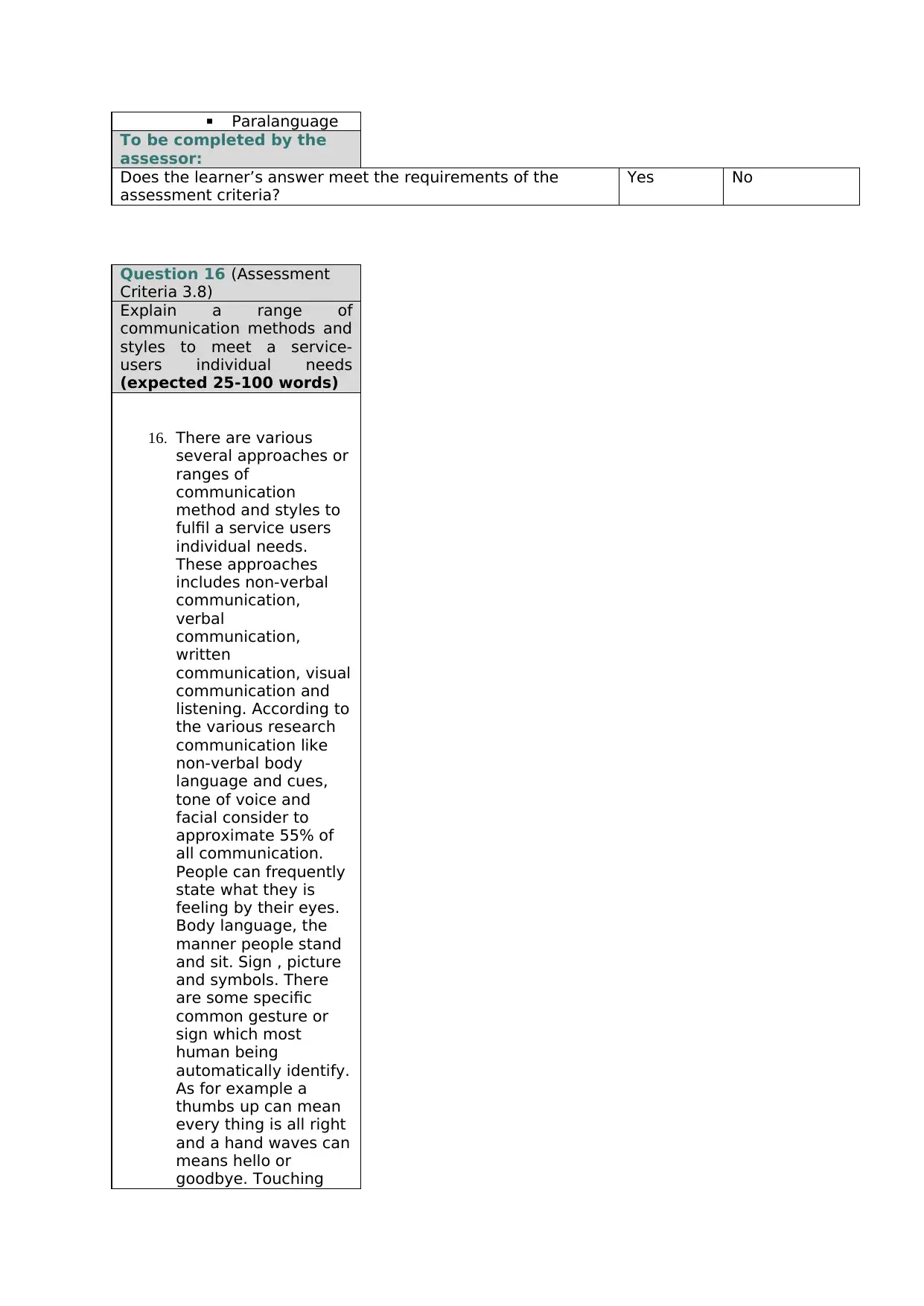
▪ Paralanguage
To be completed by the
assessor:
Does the learner’s answer meet the requirements of the
assessment criteria?
Yes No
Question 16 (Assessment
Criteria 3.8)
Explain a range of
communication methods and
styles to meet a service-
users individual needs
(expected 25-100 words)
16. There are various
several approaches or
ranges of
communication
method and styles to
fulfil a service users
individual needs.
These approaches
includes non-verbal
communication,
verbal
communication,
written
communication, visual
communication and
listening. According to
the various research
communication like
non-verbal body
language and cues,
tone of voice and
facial consider to
approximate 55% of
all communication.
People can frequently
state what they is
feeling by their eyes.
Body language, the
manner people stand
and sit. Sign , picture
and symbols. There
are some specific
common gesture or
sign which most
human being
automatically identify.
As for example a
thumbs up can mean
every thing is all right
and a hand waves can
means hello or
goodbye. Touching
To be completed by the
assessor:
Does the learner’s answer meet the requirements of the
assessment criteria?
Yes No
Question 16 (Assessment
Criteria 3.8)
Explain a range of
communication methods and
styles to meet a service-
users individual needs
(expected 25-100 words)
16. There are various
several approaches or
ranges of
communication
method and styles to
fulfil a service users
individual needs.
These approaches
includes non-verbal
communication,
verbal
communication,
written
communication, visual
communication and
listening. According to
the various research
communication like
non-verbal body
language and cues,
tone of voice and
facial consider to
approximate 55% of
all communication.
People can frequently
state what they is
feeling by their eyes.
Body language, the
manner people stand
and sit. Sign , picture
and symbols. There
are some specific
common gesture or
sign which most
human being
automatically identify.
As for example a
thumbs up can mean
every thing is all right
and a hand waves can
means hello or
goodbye. Touching
Paraphrase This Document
Need a fresh take? Get an instant paraphrase of this document with our AI Paraphraser
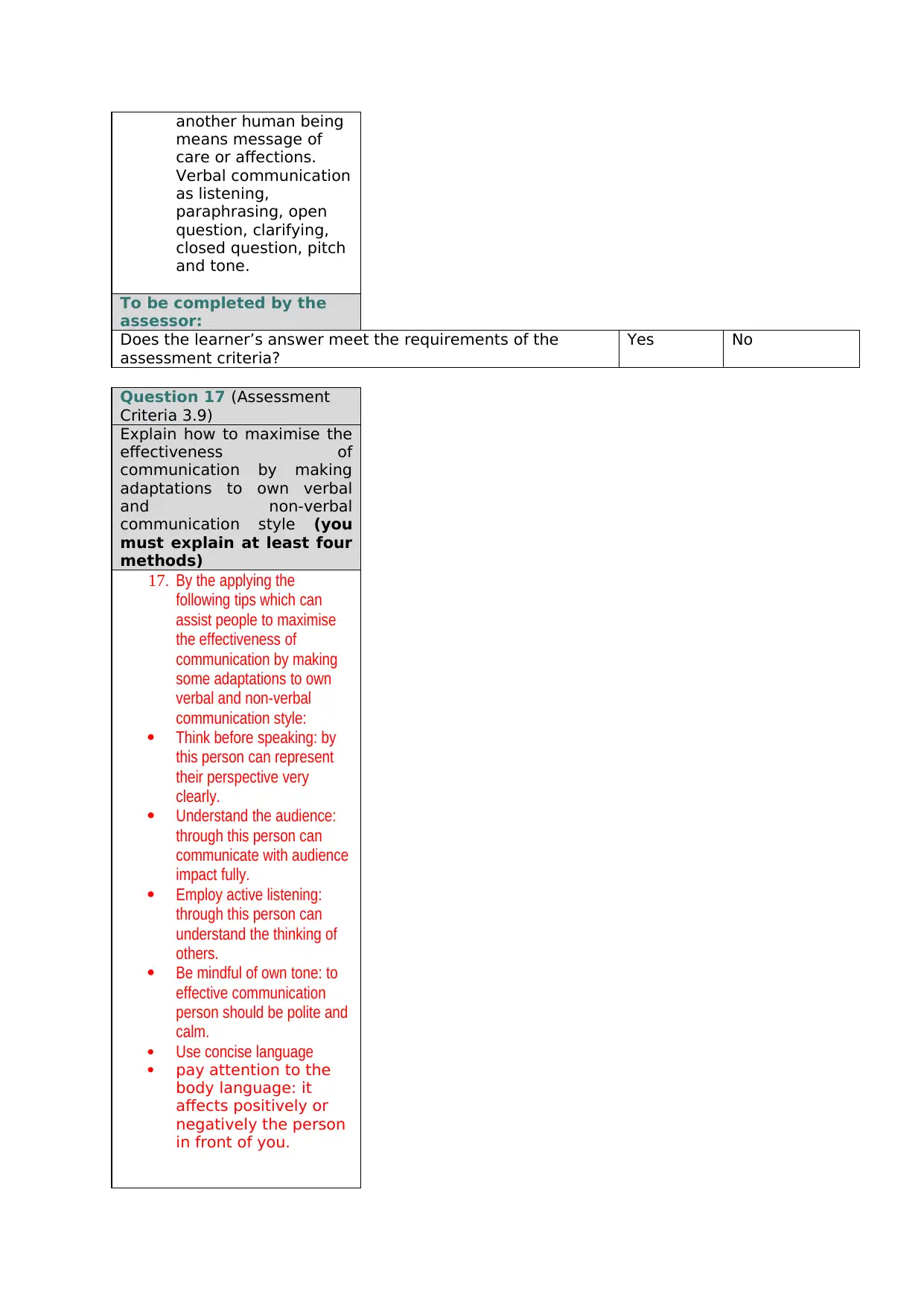
another human being
means message of
care or affections.
Verbal communication
as listening,
paraphrasing, open
question, clarifying,
closed question, pitch
and tone.
To be completed by the
assessor:
Does the learner’s answer meet the requirements of the
assessment criteria?
Yes No
Question 17 (Assessment
Criteria 3.9)
Explain how to maximise the
effectiveness of
communication by making
adaptations to own verbal
and non-verbal
communication style (you
must explain at least four
methods)
17. By the applying the
following tips which can
assist people to maximise
the effectiveness of
communication by making
some adaptations to own
verbal and non-verbal
communication style:
Think before speaking: by
this person can represent
their perspective very
clearly.
Understand the audience:
through this person can
communicate with audience
impact fully.
Employ active listening:
through this person can
understand the thinking of
others.
Be mindful of own tone: to
effective communication
person should be polite and
calm.
Use concise language
pay attention to the
body language: it
affects positively or
negatively the person
in front of you.
means message of
care or affections.
Verbal communication
as listening,
paraphrasing, open
question, clarifying,
closed question, pitch
and tone.
To be completed by the
assessor:
Does the learner’s answer meet the requirements of the
assessment criteria?
Yes No
Question 17 (Assessment
Criteria 3.9)
Explain how to maximise the
effectiveness of
communication by making
adaptations to own verbal
and non-verbal
communication style (you
must explain at least four
methods)
17. By the applying the
following tips which can
assist people to maximise
the effectiveness of
communication by making
some adaptations to own
verbal and non-verbal
communication style:
Think before speaking: by
this person can represent
their perspective very
clearly.
Understand the audience:
through this person can
communicate with audience
impact fully.
Employ active listening:
through this person can
understand the thinking of
others.
Be mindful of own tone: to
effective communication
person should be polite and
calm.
Use concise language
pay attention to the
body language: it
affects positively or
negatively the person
in front of you.
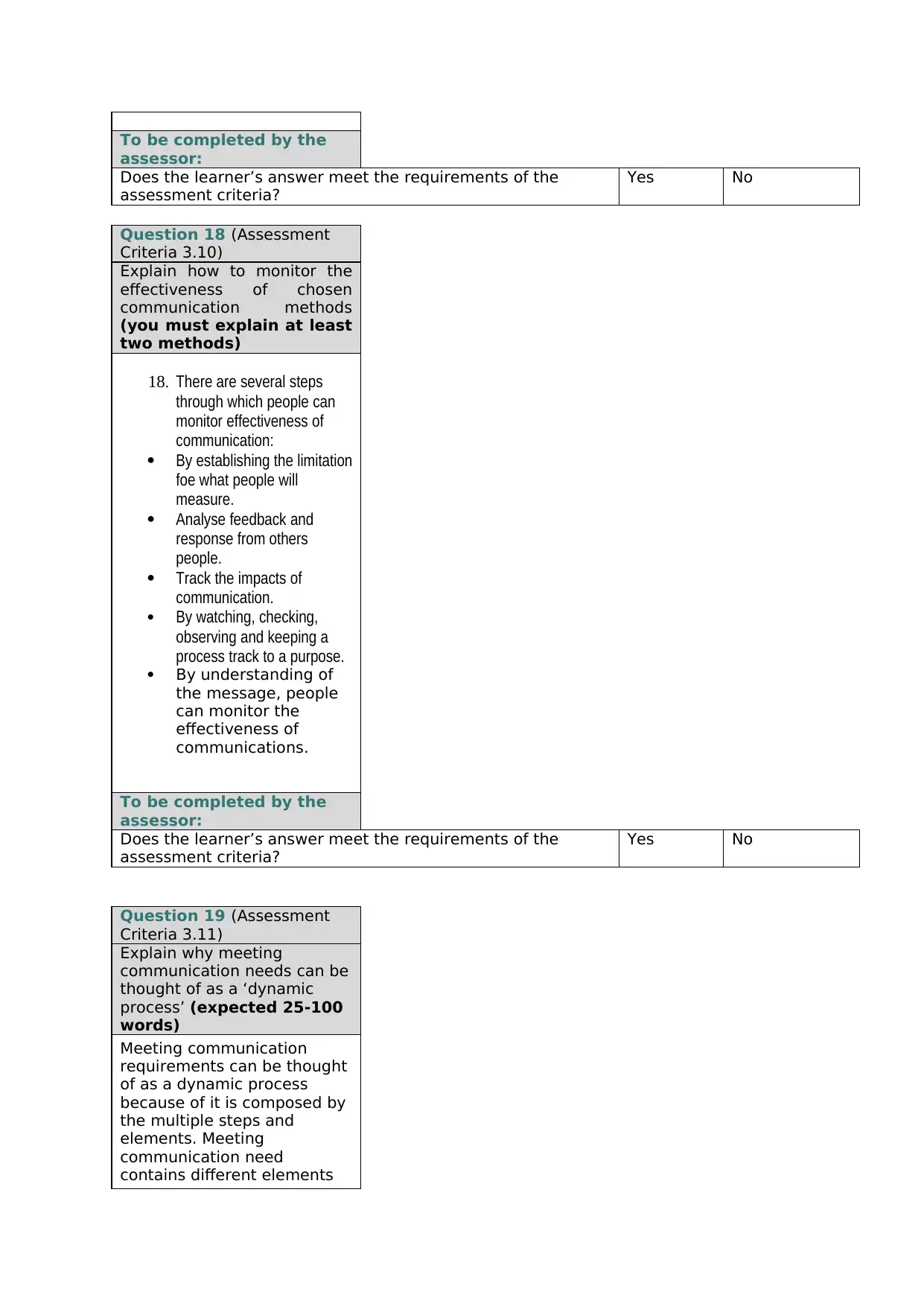
To be completed by the
assessor:
Does the learner’s answer meet the requirements of the
assessment criteria?
Yes No
Question 18 (Assessment
Criteria 3.10)
Explain how to monitor the
effectiveness of chosen
communication methods
(you must explain at least
two methods)
18. There are several steps
through which people can
monitor effectiveness of
communication:
By establishing the limitation
foe what people will
measure.
Analyse feedback and
response from others
people.
Track the impacts of
communication.
By watching, checking,
observing and keeping a
process track to a purpose.
By understanding of
the message, people
can monitor the
effectiveness of
communications.
To be completed by the
assessor:
Does the learner’s answer meet the requirements of the
assessment criteria?
Yes No
Question 19 (Assessment
Criteria 3.11)
Explain why meeting
communication needs can be
thought of as a ‘dynamic
process’ (expected 25-100
words)
Meeting communication
requirements can be thought
of as a dynamic process
because of it is composed by
the multiple steps and
elements. Meeting
communication need
contains different elements
assessor:
Does the learner’s answer meet the requirements of the
assessment criteria?
Yes No
Question 18 (Assessment
Criteria 3.10)
Explain how to monitor the
effectiveness of chosen
communication methods
(you must explain at least
two methods)
18. There are several steps
through which people can
monitor effectiveness of
communication:
By establishing the limitation
foe what people will
measure.
Analyse feedback and
response from others
people.
Track the impacts of
communication.
By watching, checking,
observing and keeping a
process track to a purpose.
By understanding of
the message, people
can monitor the
effectiveness of
communications.
To be completed by the
assessor:
Does the learner’s answer meet the requirements of the
assessment criteria?
Yes No
Question 19 (Assessment
Criteria 3.11)
Explain why meeting
communication needs can be
thought of as a ‘dynamic
process’ (expected 25-100
words)
Meeting communication
requirements can be thought
of as a dynamic process
because of it is composed by
the multiple steps and
elements. Meeting
communication need
contains different elements
⊘ This is a preview!⊘
Do you want full access?
Subscribe today to unlock all pages.

Trusted by 1+ million students worldwide
1 out of 22
Related Documents
Your All-in-One AI-Powered Toolkit for Academic Success.
+13062052269
info@desklib.com
Available 24*7 on WhatsApp / Email
![[object Object]](/_next/static/media/star-bottom.7253800d.svg)
Unlock your academic potential
Copyright © 2020–2025 A2Z Services. All Rights Reserved. Developed and managed by ZUCOL.




